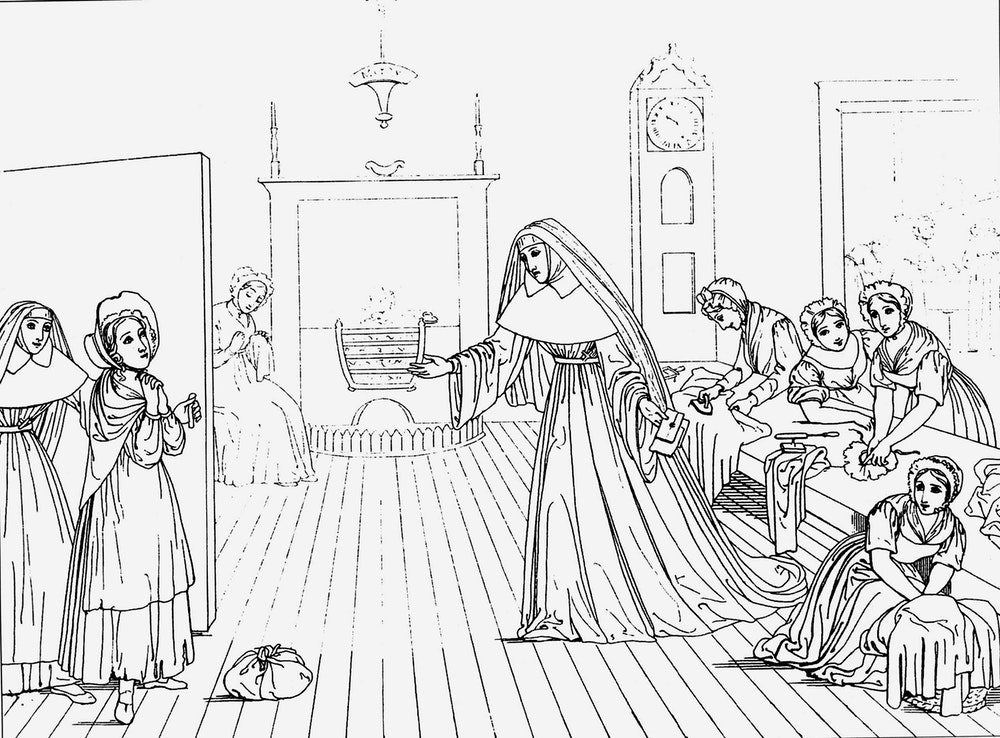In this year’s Lenten reflection series, seven sisters offer their personal stories and insights on each of the Corporal Works of Mercy and how acts of mercy can have a profound impact on the lives of our sisters and brothers. Accompanying these reflections are line drawings by Sister Mary Clare Agnew, a contemporary of Catherine McAuley, which illustrate the Sisters of Mercy in ministry in 1830s Ireland. The reflection series also includes reflections for Ash Wednesday, Palm Sunday, Holy Thursday and Easter.
By Sister Joanne Whitaker, Volunteer, Project HOME, Philadelphia, Pennsylvania
Who do you picture as homeless when you hear these words, shelter the homeless? The image that readily comes to mind for most of us is men and women on the streets in our big cities. These are the pictures we see in the newspapers and on TV. These are the homeless most of us encounter. Today we may also think of the people fleeing from their homes in Ukraine, and this may remind us of the tragic loss of so many fleeing from war in Syria and from conflict in Africa.
Why are people homeless? Around the world, war, gang violence, ethnic intimidation, natural disasters and state-supported terror cause people to flee their homes. For most people on the streets in urban areas the causes are more complex. Mental health issues, addiction, domestic violence, human trafficking, poverty all can lead to a person or a family becoming homeless. There is no simple answer to the question.
This Work of Mercy, “Shelter the homeless,” must mean more than making sure that everyone has a roof over her head, as basic and important as that is. The homeless shelters in our cities, the tents in refugee camps, the warehouses on our southern border are not homes.

What comes to mind when you hear the word home? For most of us, this is the place where we feel safe, find comfort, put down roots, experience family and community, create memories and live with contentment.
I remember a scene at the refugee camp in Namibia when the Angolan war ended after 27 years, and repatriation began. As people boarded the buses that would take them to the airport for the flight to Angola, tears streamed down their faces as they commented, “We never thought we would go home.” This to a country destroyed and, for some born in exile, never seen. Shortly after 9/11, I was heading to the airport for a flight back to Philadelphia when a woman, a refugee from Rwanda, asked me if I was afraid. Before I could respond, she said, “Oh, no. You are going home.”
What can we do to shelter the homeless and give them a place to call home? Praying for them and praying for people trying to address the problem with material support and with advocacy for policy and social change are the places to start. Prayer and reflection on the issues around homelessness may lead us to action. The flight into Egypt (Mt. 2:13-23) is a place I turn to when praying for the homeless. It gives me comfort to remember that Jesus was so fully human that He and His family were forced to flee their home and live as refugees in Egypt. God knows the suffering of the homeless.
What actions can I take? This is the season of Lent. We are called to almsgiving. We may think about contributing to agencies that work with the homeless by sharing our time, talent and treasure. We may support advocacy for policy changes leading to more affordable housing, living wages, access to childcare, increased funding for education, mental health and addiction treatment. The Institute Justice Office alerts us to actions regarding all these issues. We can do it. They make it easy. You may have your own ideas for actions to end homelessness.
Unfortunately, the solutions to homelessness caused by war appear even more difficult. Let us pray for peace and ask God to enlighten the hearts of world leaders.
May we all work to end the suffering of those who are homeless. May God ease them of their burden.